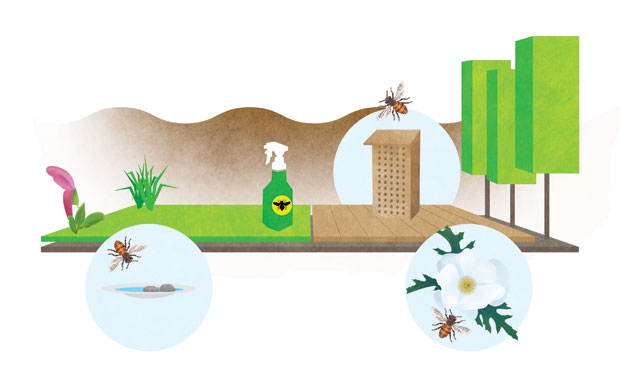Green Room: Combating the Zom-bee Apocalypse
By James Nakamura
Last month, riding high on the up-current of National Pollinator Week, 50,000 such pollinators met their untimely ends, dropping from a linden tree onto the asphalt of a discount store parking lot in what was reported as one of the largest mass bumble bee deaths on record. This was overseas. Back home, you may see a worker bee blissfully hovering over the stamen of a hibiscus, and it may be easy to miss the darker environmental forces stacked against it worldwide. Natural predators, climate change and pesticides over the last decade have not been kind. There is a chance that its colony will not survive the year.
There is some hope. Just last month, Gov. Neil Abercrombie signed a bill aimed at bolstering Hawaii’s beekeeping industry. This includes funding for an apiary program tasked with managing resources and education on maintaining healthy hives. And despite reporting a high rate of colony deaths, many beekeepers have persevered and brought their hive numbers back up.
This doesn’t mean that our bees are in the clear. Legislation and professional hive management aside, there are things that can be done even on our own homefronts to help our friendly neighborhood bees along. After all, in this ongoing crusade, the scales could be tipped right in our own back yards.
1. PREPARE A WATERING HOLE
Ensure that there is a constant clean supply of water in your yard by creating a bee bath. Most bees can’t land in deeper pools of water and will drown when making an attempt. Use a shallow bowl or saucer and line it with rocks. Add water but take care not to submerge the rocks completely, as they will act as little islands for the bees to land on. As bees catch on to this oasis, you’ll soon reap the benefits of having a well-pollinated garden.
2. MINIMIZE COLLATERAL DAMAGE
Avoid using neonicotinoid pesticides in your garden. Neonicotinoids will turn bees into zombies — the flying dead. This nicotine-based insecticide causes brain damage among bees either through direct contact or residual hive contamination. Colonies that seem healthy eventually become disoriented — abandoning their hives and dying off in large numbers. Three offending pesticides have already been banned in Europe. And after aforementioned massive bumble bee death in Oregon due to treated linden trees in bloom, the Oregon Department of Agriculture has enacted a statewide ban on Safari, a neonicotinoid. Beware any of these ingredients in any gardening product — Acetamiprid, Clothianidin, Dinotefuran, Imidacloprid, Nitenpyram, Thiacloprid and Thiamethoxam. These neonicotinoid pesticides are currently being investigated in the United States, so they will continue to be available. In the meantime, be diligent about which products you use in your garden, from pre-treated seeds to potting soils. Instead, go for safer, natural and organic pesticides.

3. PROVIDE ASYLUM
Not all bees belong to a hive, although they are most likely the ones that come to mind. Of the wide variety of bee species in Hawaii, 90 percent of them are solitary bees, with approximately 60 different types in Hawaii. Most of them nest in the soil, under dried leaves, or in pieces of dry wood. You can encourage these solitary drifters to hole up in your backyard by creating your own bee motel. Cut a long hollow bamboo branch into shorter pieces and tie them together in a bundle. Make sure to place them in a safe and sheltered area with their open ends facing south east. This ensures that the bees will get the early sunrise wake up call they need. You can also used untreated blocks of wood, old logs or stumps. Drill holes into one side that are 3/8-inches wide in diameter, and 3/4-inches wide on the inside. Also be sure to secure them firmly so that they aren’t rocked or blown in the wind. Unhappy customers won’t return.
4. BOLSTER THEIR RATIONS
Plant flowers in numbers and arrange them in patches. Bees see a wider range of colors than we can so they’ll certainly appreciate any floral artistry. Native plants will work better at attracting bees that are adapted to each region, so opt for native Hawaiian plants such as Yellow Ilima or the Pink Lokelani. You can provide a steady food supply for bees by planting a variety of plants with staggered blooming times that will keep your color-by-numbers garden buzzing year-round. The more colorful your garden, the wider variety of bees you’ll attract.
5. DIG TRENCHES
Most of all bee species, around 70 percent, are ground-nesting bees. They dig their tunnels in the soil, and their queens stock them with their brood and food stores. For sandpits, choose a well-drained area with a lot of sunlight. Dig a hole about 2 feet deep and fill it with sand and loam. For bare ground nests, find a patch of soil and clear it of all vegetation. Make sure that it is on a slope in a sunny, open space. Compact the soil lightly. You can also do the same with planter boxes and soil or sand as long as they are untreated.
DID YOU KNOW: One third of the world’s crops are dependent on honey bees. Without honey bees, we would have to say goodbye to apples, almonds, cherries, blueberries, avocado, broccoli, most leafy greens, cucumbers, pumpkins, grapefruits, onions, oranges and much more.